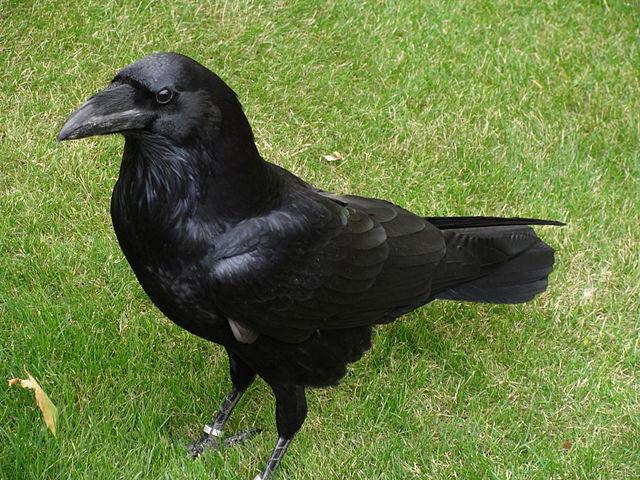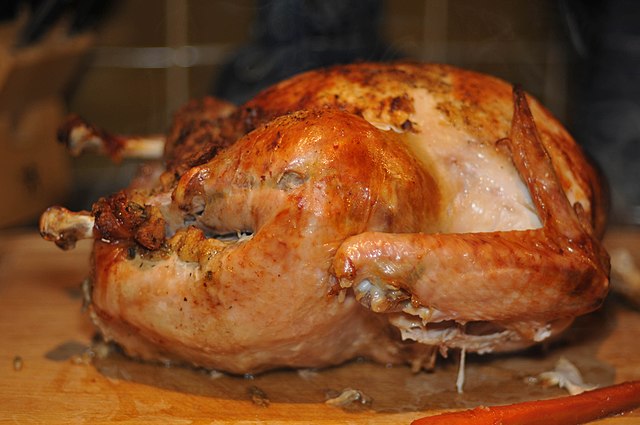In Irish folklore the raven was thought to be a messenger from the other world.
Autumn is upon us. The leaves have gone gold and scarlet, night falls earlier, the air turns chill, and the season to plant crops won’t come again until spring. For our ancestors, it was time to breathe a sigh of relief that summer had produced a bountiful harvest and rejoice in that good fortune with a feast. In ancient Ireland, the final harvest celebration was known as Samhain, the three-day period of the full moon midway between the fall equinox and winter solstice, which usually occurred in early November.
As every schoolchild learns, the Puritan colonists of Massachusetts celebrated surviving their first year in North America with an elaborate feast in November, which coincidentally lasted three days. Much less known is the fact that this early band of European immigrants would never have made it to that event had they not been rescued from starvation nine months earlier. On February 21, 1621 the Irish-registered ship Lyon arrived at Plymouth with a full cargo of supplies that had been sent by a Dublin merchant whose daughter was married to one of the Puritan congregation.
With supermarkets today offering culinary abundance flown in year-round from every corner of the globe, 21st-century moderns have no cause to worry about having enough food to make it through the winter. Even so, Americans still gather for a feast of Thanksgiving in November, and the featured entrée of that meal is the continent’s native bird, the turkey.
Unique to the Americas, the turkey almost played a far bigger role in American history. When designs were being considered for the Great Seal of the United States, Benjamin Franklin opined that an image of the wily American turkey would be a fine choice for the central motif, but his fellow statesmen voted instead to make the bald eagle the official American avian symbol.
While many countries, especially those in Europe, have designated “national” birds, Ireland does not. This is somewhat curious since one particular family of winged beauties, the Corvids (which includes ravens, crows, and rooks) figure repeatedly in Irish myth.
The raven is the largest member of the group, measuring as much as three feet from beak to tail, with long wings that enable it to perform extremely agile aerial acrobatics, and glossy black plumage that ornithologists believe is an asset for retaining heat in cold Northern climes. While they gather in social groups when fledglings, by the age of three years ravens mate in lifelong monogamous and very territorial pairs. Their sounds range from deep croaks and high-pitched “tocs” to grating “kaas,” but ravens can also mimic the voices of other birds and animals. When captive, the highly intelligent birds can even learn to replicate words spoken by their handlers.
Ravens appear in several Celtic myths and legends. They were the favored bird of Lludd, the god of artists and artisans, who had two raven attendants that supplied him all his life with all his needs. The fierce warrior and son of Lugh, God of Light, Cu Chulainn, who single-handedly defended Ulster against the forces of Connacht’s Queen Mebh in the Táin Bó Cúailnge (The Cattle Raid of Cooley), was not believed to be dead until a raven perched on his shoulder. Ravens were also thought to be messengers from the Other World, and like the wail of the Bean Sidhe, their piercing cry could foretell imminent death for someone.
The Raven is closely linked to the Morrigan, one of the most complex deities in the Celtic pantheon. A “triple” goddess, whose sphere of influence includes fertility, birth, and death, she is also known as Badb Catha (Battle Raven), Macha (Sovereign Queen), and Nemain (Terror). On the bank of the River Unshin, County Sligo, she is said to have seduced and joined with the All-Father Dagda at Samhain in an annual renewal of the life and death cycle. The Morrigan is best known, however, for her warrior nature especially when her favored people, the Tuatha de Danaan, are threatened. In the tale Cath Maige Tuireadh (The Battle of Mag Tuired) she shape-shifts into an immense raven, swoops over the battlefield shrieking “kaas” so fearful the enemy drops dead on the spot, and carries off her valiant fallen to their afterlife reward. Since the Morrigan always knew in advance the outcome of any battle, the Irish proverb “…has a Raven’s knowledge” means the person it describes can see into the future.
While the raven is indeed a black bird, it is not a blackbird, which belongs to an entirely different family, the thrush genus. And while Ireland’s raven is not known to have ever taken top billing on any menu like America’s turkey, the blackbird’s role in medieval Irish feasts is legendary. Remember “four and twenty blackbirds baked in a pie?”
That the birds in this beloved kiddies’ jingle began to sing once the pie was opened may seem like fiction, but it’s not. In a noble’s home during the Middle Ages, the main meal was the main event. This was especially true when royalty came to call, which happened far too frequently for many a landowner’s peace of mind and pocketbook. We think of kings and queens staying home and bidding the world come to them, but such was not the case at all. Rulers spent months on the road, arriving at the gate of their loyal subjects’ manors with huge retinues – coachmen, footmen, mounted guards, foot soldiers, stablehands, personal attendants, seamstresses, blacksmiths, and lords and ladies in waiting who had their own servants as well.
With little more amusement than perhaps a morning’s hunt, dining was the chief entertainment. There were lute players and singers, meat carvers as deft as jugglers, pomp, ceremony, and a non-stop parade of surprises from the kitchen. Producing elaborate edible fantasies – like live birds caged inside a faux pie – marked a household’s sophistication and wealth.
Another favorite way to wow regal diners was the “bird in a bird in a bird in a bird” presentation. A small quail was stuffed inside a larger guinea hen which was stuffed inside an even larger bird and so on and so on, until the final bird (usually a swan or peacock) came to the table feathered, gilded, and perhaps even wearing a tiny crown. That particular Medieval culinary masterpiece still graces feasting tables today as a “tur-duck-en” (chicken in a duck in a turkey) and, if you’re in the mood to serve something a wee bit different for your Thanksgiving meal this November, one can be ordered from a specialty poultry provider. Sláinte!
RECIPES
Turkey Ingredients
15-pound turkey, oven ready
Salt, black pepper, and a little flour
2 tbsp. soft butter
8 slices streaky bacon
Stuffing Ingredients
1-pound loaf of bread, broken into pieces
6 tbsp. fresh parsley, chopped
2 tbsp. fresh thyme, chopped
1 medium onion, cut into quarters
Salt and black pepper
2⁄3 cup butter, softened
To Cook
To make the stuffing
Place the bread, parsley, thyme, and onion in a food processor. Process until you have fine breadcrumbs and the onion is finely chopped. Remove to a bowl, season and mix in the butter.
To stuff the turkey
Loosen the skin at the neck end with your hands. Pack the stuffing in, pushing it up between the flesh and the skin, but not too tightly because it will expand during cooking. Tuck the neck flap under the bird’s back and secure it with a toothpick. Any remaining stuffing can be cooked in a covered baking dish with the turkey. Weigh the turkey and calculate the cooking time. Allow 15-20 minutes per lb. Place the turkey breast side up in an oiled roasting tin.
To cook the turkey
Preheat the oven to 450°F
Season the turkey inside and out with salt and pepper and dust with a little flour. Rub all over with the butter, then lay the bacon slices on the breast, overlapping each other. Cover the bacon with a piece of buttered parchment paper. This will keep the bacon in place. Wrap the turkey in foil and roast in the preheated oven. After the first 30 minutes, reduce the heat to 325°F. Baste a couple of times during roasting. For the last half hour, remove the foil.
To check if the turkey is cooked, pierce the thickest part of the leg, the juices should run clear.
When the turkey is cooked, remove from the oven and transfer to a large plate. Reserve the cooking juices in the tin to make the gravy. Cover the turkey loosely with foil and let rest for half an hour in a warm place until you are ready to serve it.
(Bord Bia – Irish Food Board)
℘℘℘
Guide to Good Gravy
A well-flavored stock is important, so a day ahead, place the giblets, some onion slices, and a bay leaf in a saucepan. Cover with water, then simmer gently for 1½ – 2 hours. Then strain, season, and refrigerate. After removing the turkey from the roasting tin, pour off the fat and leave behind the juices. Over medium heat, stir in a tablespoon of flour. Blend well. Add a dash of wine. Continue to cook. Stir in the stock and simmer for 2-3 minutes. A tablespoon of red currant jelly, cream, or balsamic vinegar will also add to the flavor. Season to taste. ♦



Do you know that Edgar Allan Poe is also half Irish-American?
Those mysterious birds. I have a family of three on my roof now. Three Crows is also the family flag of my late mother’s clan, the Kirwans.
Thanks.
I have always interacted with crows and ravens. I think they can pass on info about you to other birds and can recognizeyou after they move from
your teritory. Unfortunately, I have not seen birds, bugs fles butterflies fireflies and misquetoes (yeah ) in my yard for years. I no longer need to shut the door immeditetly to keep them out of the house. They’re not there.
One day I spotted a family of 3. (One usually stays with the parents)
The odd one was carrihg a stick and dropped it when he saw me look at him. He followed me a mile or so flying back and forth in front of me.
I entered a large buildig and exeted at the far end there on top of a pole
was a crow cawing at me. They all look alike to me. Hard to tell if it was
the same one.
In the last paragraph, my heart sank. I really do not want to destroy a barbecue press with rice in three seconds
Edgar Alan Poe has become so connected to Ravens thats their carved on his Headstone thats because of his classic poem The Raven
Be careful with Crows they can remember a face and if you mistreat them Theil hold a Grudge against you for life